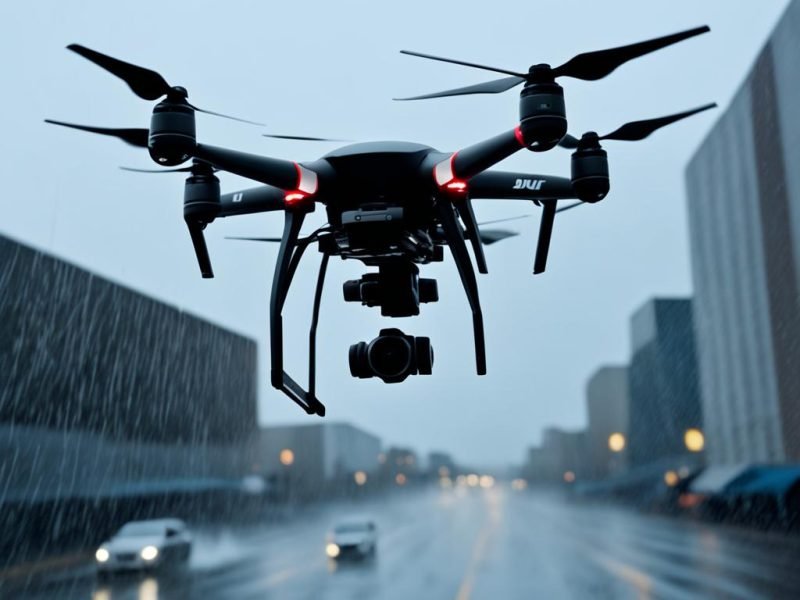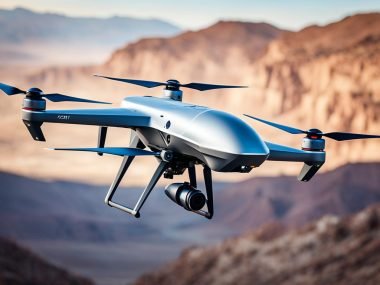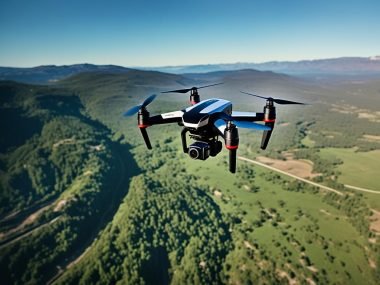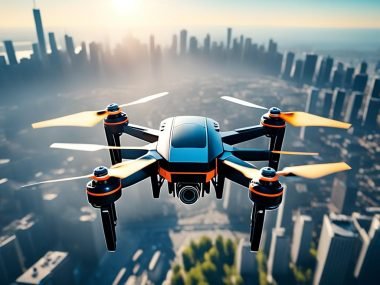We’ve all looked up, watching our drones fly high, taking amazing shots. But one question keeps us wondering: Can a DJI drone fly in rain? This question matters. Especially to those who’ve put their money and heart into their drones. We’ve seen videos of drones like the Mavic Air 2 and Mavic Pro flying in light rain. This makes us curious and sometimes daring.
Before we fly our drones in the rain, we think carefully about it. Once we decide to try, we see water drops on our camera lenses. It’s a real test of the DJI drone’s ability to withstand water.
Flying a drone in misty conditions is fascinating yet risky. This balance of beauty and caution captures the drone community’s attention.
Key Takeaways
- Understanding the potential and limits for flying a DJI drone in wet weather conditions.
- Evaluating drone rain resistance and what it means for pilots considering flight during rainfall.
- Recognizing the risks and practical implications of water droplets on drone lenses.
- Assessing the DJI drone water rating against the backdrop of pilots’ personal experiences.
- Emphasizing the importance of calculated risks for safely operating drones in drizzle.
User Experiences with DJI Drones in Wet Conditions
Many drone lovers fly DJI drones in bad weather. They share stories within the community. These stories teach us about the durability of drones in rain.
Real Pilots’ Anecdotes: Drones in the Rain
Some pilots share success stories about waterproof DJI drones. But, they also talk about the risks. Each tale is a reminder of the risks and rewards of flying in wet weather.
Unexpected Weather Challenges: Accounts of Quick Action
Chasing storms with drones can be risky. Pilots speak of sudden weather changes. They tell of how they quickly land and dry their rainproof drones.
We stand united in our respect for the elements; and in our commitment to protect our aerial companions from the caprices of Mother Nature, even as we seek to capture her fleeting moods.
Collateral Effects: Water on Drone Lenses
One constant challenge is rain on the camera lens. Even Waterproof DJI drones can get blurry shots from raindrops. This issue ruins the quality of the images from above.
Let’s look at a table showcasing pilots’ experiences in wet conditions:
| Condition | Outcome | Common Action |
|---|---|---|
| Light Rain | Successful Flight | Monitoring |
| Heavy Rain | Risk of Damage | Immediate Landing |
| Water on Lens | Poor Image Quality | Lens Cleaning Post-Flight |
These stories emphasize the value of waterproof and bad-weather flying skills. They remind us to balance adventure with safety.
In rain or storm, these stories teach a lesson. They show the importance of knowing when to fly or stay low. For adventurers into the grey skies, remember to be bold yet cautious.
Risk Assessment and Water Resistance
Heading into a drizzly skyline requires thinking about the risks of DJI drone water damage. Water is a big enemy of electronics, including drones. It’s key to weigh the possible costs, as water can permanently damage your drone’s parts.
DJI Drones and Water Damage: An Overview
Capturing views from the sky is tempting, no matter the weather. But flying a DJI drone in bad weather walks the fine line between amazing sights and potential damage. Rain can harm the high-tech parts inside your drone, causing issues like rust or short-circuits. So, it’s smart to be careful about where and when you fly.
The Implications of Flying in Adverse Weather Conditions
Chasing storms might sound exciting, but flying drones in wet weather has its risks. Water getting into your drone might just start as an annoyance. But, it can quickly turn into a big problem, risking the drone failing while in the air. This highlights the importance of drone rain resistance and the need to protect your drone from rain.
Official DJI Stance on Wet Weather Operation
DJI drones are often leading in tech advancements. Still, they have their limits, especially with weather. Following the DJI drone water rating is key to keeping your drone safe. We’ll look at the manufacturer’s thoughts on DJI drone rain resistance.
Drone lovers should note, DJI advises not flying drones in the rain. This is crucial for drones like the DJI Mavic Air 2. DJI sets temperature and environment advice to protect the drone. These tips show the care and detail put into making these drones work best.
Flying a drone in ideal conditions is always the best practice, but being prepared for unexpected changes in weather is equally important. Always consult the official DJI guidelines before operating your drone in less-than-ideal conditions.
Knowing the DJI drone rain resistance limits is vital. As drones get better, their parts become more delicate to moisture. This could lead to damage from rain or snow. So, following the DJI drone water rating keeps your drone going longer and encourages safe flying.
Before flying, think about these DJI policies. If the weather suddenly changes, reacting quickly and following the rules can prevent damage to your drone.

Drone Piloting Practices in Rain
Flying a drone when the weather is bad can be scary and exciting. Thanks to rainproof drones and new drone rain resistance tech, it’s important to know how to fly these advanced machines in wet skies.
Best Practices for Wet Weather
Our main advice is simple: try not to fly in rain if you can avoid it. But sometimes, the weather can catch us off guard. When that happens, it’s key to have emergency landing spots in mind and keep an eye on the weather forecast before flying. This careful planning helps us keep our DJI drones, known for their quality and dependability, in top shape.
Emergency Precautions for Unexpected Rainfall
When light rain turns into a heavy pour, it’s critical to take emergency precautions for DJI drones right away. Our first step is always to bring the drone back safely. Once we have it, we dry the outside carefully and put the drone somewhere dry to get rid of any moisture left. Using silica gel packs or other methods to soak up moisture is key in our emergency plan. This helps our waterproof drones stay tough against the weather. Being ready for sudden rain means we’re always prepared, ensuring our drones can fly another day.
By following these tips and knowing the current limits of drones in bad weather, we protect our drones. This lets us keep enjoying the excitement of flying, no matter the weather.
Protective Accessories for DJI Drones
Flying DJI drones has pushed us to explore new areas. We often face conditions that need extra protection from the weather. The market has answered with protective accessories for DJI drones, like drone wetsuits and DJI drone rain covers. Today, we’re focusing on how these accessories can help keep your drone safe and give you peace of mind.
Market Options for Drone Wetsuits and Rain Proofing
Looking around, we find many accessories that offer water resistance during light rain flights. Drone wetsuits are especially noteworthy. They fit your DJI drone perfectly and keep moisture out. But keeping your drone dry isn’t the only concern; assessing water protection is key before flying under grey skies.
Assessing the Efficacy of DJI Drone Rain Covers
Conversations about DJI drone rain covers often focus on how well they work. They’re designed to protect your drone from light rain. But you have to look closely at whether they really perform as promised. Below, we’ve listed different rain protection options and how they stack up:
| Accessory Type | Material | Compatibility | User Feedback |
|---|---|---|---|
| Drone Wetsuit | Water-resistant Fabric | Various DJI Models | Positive with caveats |
| Rain Cover | Transparent Plastic | Specific to Model | Mixed, dependent on weather |
| Silicone Motor Covers | Durable Silicone | Universal Fit | Highly recommended |
| Propeller Shield | Lightweight Composite | Selected Models | Good for light drizzle |
Even though we can’t control the weather, we can control how we prepare. Using protective accessories for DJI drones is a smart way to change flight outcomes. But remember, no accessory can guarantee 100% water protection. It’s always best to fly carefully and be ready for anything.
Can A DJI Drone Fly In Rain?
When wondering whether a DJI drone can handle rain, it’s not a simple yes or no answer. Drone pilots would love a rainproof feature, but it’s complicated. Some have flown their drones in light rain and were okay, but there’s a big risk. Stories of DJI drone water damage remind us to be careful.

We’ve looked into how well DJI drones do in bad weather. We wanted to know their limits. Our findings help drone lovers decide if they should fly in the rain or not.
| Weather Condition | Impact on Drone | Recommendation |
|---|---|---|
| Light Drizzle | Possible lens water spots, minor risk of internal moisture | Short, cautious flights; immediate drying after use |
| Moderate Rain | High risk of water ingress, reduced control response | Avoid flying, protect drone with a cover if caught unintentionally |
| Heavy Rainfall | Critical risk of water damage, potential malfunction | Do not fly, as risk of permanent damage is significant |
So, what’s the bottom line? DJI drone water damage is a real danger. We have to think hard before flying in bad weather. Even with better tech, drone rain resistance isn’t good enough for rainy flights yet.
Always be wise and know the weather’s impact on our high-tech gear.
Technical Enhancements for Water Evasion
The design of DJI drones includes special technical enhancements. These upgrades boost their ability to resist water. With water evasion technology leading the charge, drone users won’t worry in sudden rains.
Internal Flow Channels: A Technological Overview
DJI has smartly built internal flow channels in their drones. These channels keep water away from important parts. This protects the drones from water damage, showing DJI’s focus on making drones safer and longer-lasting.
But, these technical enhancements don’t mean drones should fly in bad weather on purpose. They’re meant to help if a drone accidentally meets water. This feature lets pilots fly with more confidence in damp places.
The Balance Between Waterproofing and Performance
Finding a balance between keeping drones dry and keeping them running well is tough. DJI makes drones that handle some water without losing functionality. This gives pilots peace of mind against light water contact.
It’s important to know that while DJI drones can resist some water, this balance is delicate. These drones are built to perform well without the need for being fully waterproof. Users should know these drones can handle a bit of rain but aren’t made for constant wet conditions.
Maintenance Tips After Exposure to Rain
We love getting that perfect drone shot, even in bad weather. But, rain can harm your drone. That’s why following a drone care guide is vital after rain exposure. Good maintenance can prevent lasting damage to your UAV.
Post-rain Drone Care: A Step-by-Step Guide
What you do right after your drone gets wet is crucial. Here’s a simple guide for caring for your water-exposed drone:
- Power down the drone and remove the battery immediately. This stops any possible short circuits from moisture.
- Gently dry the drone’s outside with a soft towel. Don’t use anything that could scratch it.
- Let it air dry in a warm place or use a fan. Never use a heat gun or hairdryer, which could damage it.
- Put the drone in a container with desiccants to pull out internal moisture.
Be patient and give your drone lots of time to dry. You might need to wait several days before turning it back on.
Long-term Effects of Water Exposure on DJI Drones
Water can seriously harm your drone over time. Here are some problems you might see:
- The battery could swell, making it less effective and unsafe,
- Internal parts might corrode, which is hard to spot right away,
- Electrical connections could weaken, leading to unreliable drone behavior or failure.
These issues show why following a thorough drone care guide is essential. It’s crucial for keeping your drone working well, even after getting wet.
| Issue | Immediate Action | Preventative Measure |
|---|---|---|
| Exterior Wetness | Dab dry with soft, lint-free cloth | Use water-resistant casing when flying |
| Battery Contact with Water | Remove and dry immediately | Check the seal and compartment integrity |
| Interior Moisture | Place with desiccants in a sealed container | Regularly check for signs of wear and tear on the drone’s body |
Maintaining your drone well after it gets wet doesn’t just help this one last longer. It’s also preparing you for safer flights in the future. Always try to fly in dry conditions. But if you can’t, use your drone care guide to fix any issues safely.
Conclusion
In our deep dive into using DJI drones when the weather turns bad, we found a key take-away: while these advanced machines can handle a bit of rain, flying them in such conditions isn’t wise. Flying DJI drones in rainy weather? The consensus is clear: avoiding rain reduces the risk of water damage and keeps the drones working well. Even if some pilots take the risk in wet weather, it’s smarter to be cautious and respect technology’s limits.
Thinking about whether these drones are waterproof brings us to an important point. Yes, DJI drones have some protection against moisture, but they’re not unstoppable. To keep these high-tech gadgets working well and lasting long, stick to the rules set by the makers. Also, act quickly to protect them when the weather gets bad. This smart planning lets us enjoy flying our drones without risking their future.
Our adventure in flying DJI drones teaches us to be ready for nature’s surprises. The sky might throw challenges at us, but together we learn how to deal with them. By following these tips, we protect our drones and keep our passion for exploring the sky alive. Ready for any weather, we capture the world from above with confidence.







